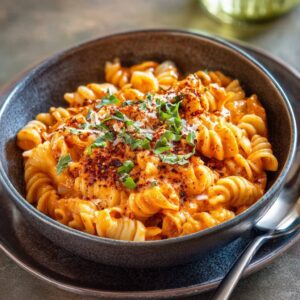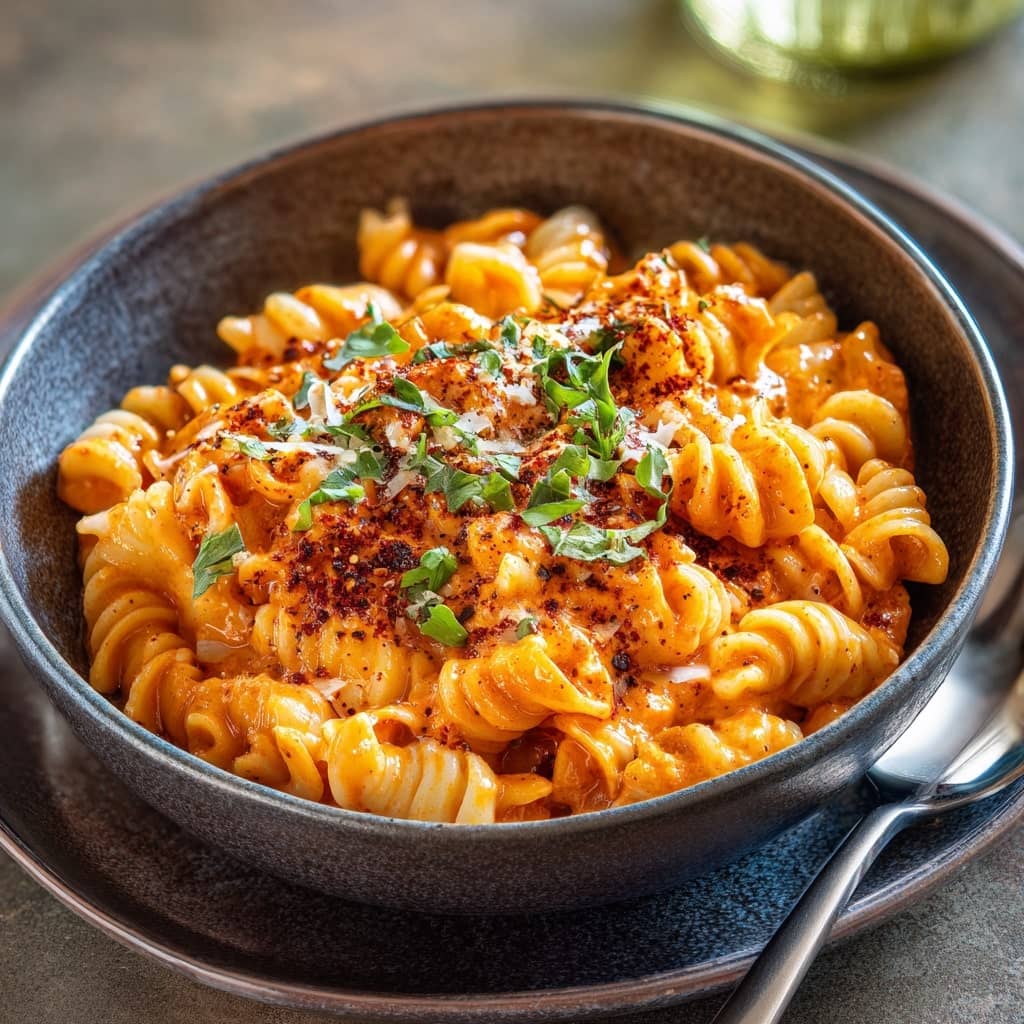Creamy Gochujang Pasta is a bold, spicy, and irresistibly comforting fusion dish that brings together the richness of Italian cream-based pasta with the deep, umami-packed heat of Korean gochujang. This vibrant dish features tender noodles coated in a luscious, velvety sauce that balances spicy, savory, tangy, and slightly sweet notes. The gochujang, a fermented red chili paste, adds complexity and depth to the creamy base, creating a mouthwatering blend of East-meets-West that’s both satisfying and unique. Whether served as a cozy weeknight dinner, a spicy date-night meal, or a restaurant-style plate at home, Creamy Gochujang Pasta is quickly becoming a beloved staple for adventurous food lovers who crave fusion comfort food with a modern kick.
The history of Creamy Gochujang Pasta is relatively recent, rooted in the wave of global fusion cuisine that gained momentum in the early 2000s and continues to thrive today. While Italian pasta has long been a culinary mainstay in Western kitchens, Korean ingredients like gochujang began rising in popularity with the global spread of Korean pop culture (K-pop, K-dramas) and cuisine, especially in the 2010s. Gochujang, traditionally used in Korean dishes like bibimbap or tteokbokki, found its way into Western kitchens where chefs and home cooks began experimenting by incorporating it into sauces, marinades, and pastas. The pairing of gochujang with cream is especially popular because it softens the spice while enhancing the sauce’s depth. This dish gained viral attention through social media platforms like TikTok and YouTube, with food bloggers showcasing its fiery yet comforting appeal. Now, Creamy Gochujang Pasta is a global favorite, celebrated for its ability to unite bold Asian flavors with familiar Western textures.
Ingredients Breakdown
– 8 oz (225 g) pasta of your choice (fettuccine, spaghetti, or penne work well)
– 1 tablespoon olive oil or unsalted butter
– 4 cloves garlic, minced
– 1 small onion, finely chopped
– 2–3 tablespoons gochujang (Korean red chili paste), adjusted to taste
– ½ cup heavy cream (or coconut cream for a dairy-free version)
– ¼ cup milk (whole milk or plant-based)
– 1 tablespoon soy sauce
– 1 teaspoon sesame oil
– Salt and pepper to taste
– Optional: grated parmesan or pecorino for topping
– Optional garnish: chopped scallions, sesame seeds, or crushed red pepper flakes
Step-by-Step Recipe
- Cook the Pasta: Bring a large pot of salted water to a boil. Add the pasta and cook according to package instructions until al dente. Reserve ½ cup of the pasta water, then drain the rest and set pasta aside.
- Sauté Aromatics: In a large skillet or saucepan over medium heat, add olive oil or butter. Once hot, add minced garlic and chopped onions. Cook for 2–3 minutes until fragrant and translucent.
- Add Gochujang: Stir in the gochujang paste and let it cook for about 1 minute to deepen its flavor. Adjust the amount depending on your heat preference.
- Make the Sauce: Lower the heat to medium-low. Pour in the cream and milk, stirring to combine with the gochujang and aromatics. Add the soy sauce and sesame oil. Let the sauce simmer for 3–5 minutes until it thickens slightly. Season with salt and pepper to taste.
- Combine Pasta and Sauce: Add the cooked pasta directly into the sauce. Toss everything together until the noodles are fully coated. If the sauce is too thick, use a splash of reserved pasta water to loosen it up.
- Finish and Serve: Turn off the heat and sprinkle with optional grated cheese. Garnish with chopped scallions, sesame seeds, or chili flakes for an extra layer of flavor and presentation. Serve immediately while hot.
Tips for the Perfect Creamy Gochujang Pasta
Use high-quality gochujang for the most authentic and rich flavor—look for brands with minimal added sugars or preservatives. Adjust the amount of gochujang to match your spice tolerance; 2 tablespoons is mild to medium, while 3 or more gives a fiery kick. Cook pasta until just al dente to ensure it doesn’t get soggy once mixed with the sauce. Always reserve pasta water—it helps emulsify the sauce and bind it to the noodles. For a silkier sauce, warm the cream and milk slightly before adding to the pan. Let the sauce simmer to develop flavor but avoid overcooking, which could cause the cream to separate. Add a protein like grilled chicken, shrimp, or tofu for a more filling dish. Use a wide skillet to toss the pasta evenly with the sauce. If using cheese, add it at the end off the heat to prevent clumping.
Variations and Customizations
To make it vegetarian, ensure your gochujang is meat-free and add sautéed mushrooms, spinach, or zucchini. For a vegan version, use coconut cream or oat-based cream, plant-based milk, and skip any cheese or use vegan cheese. If you love seafood, add pan-seared shrimp or scallops for a gourmet twist. Chicken, ground pork, or even bacon also pair beautifully with gochujang’s depth. For added crunch, toss in toasted nuts like peanuts or cashews. Swap the pasta for rice noodles or udon for an even more fusion-forward experience. Add a soft-boiled or poached egg on top for a luxurious, ramen-style finish. Mix in a teaspoon of sugar or honey if your gochujang is especially spicy and you want to mellow the heat. Garnish with kimchi for a tangy, fermented pop. For a smoky flavor, add a dash of smoked paprika or use chipotle cream instead of plain.
Health Considerations and Nutritional Value
Creamy Gochujang Pasta is a flavorful indulgence, but it can also offer nutritional benefits depending on your ingredient choices. Gochujang contains probiotics, antioxidants, and capsaicin, which may aid digestion and boost metabolism. The garlic and onions provide anti-inflammatory properties, while dairy or dairy-free alternatives can offer calcium and healthy fats. For a lighter dish, use whole wheat pasta or chickpea-based pasta for added fiber and protein. Swap heavy cream with low-fat milk or unsweetened plant-based options to cut back on saturated fat. Reduce sodium by using low-sodium soy sauce and moderating added salt. Adding vegetables or lean protein makes the meal more balanced and filling. Be mindful of portion sizes, especially if adding cheese or rich toppings. Those with dietary restrictions should check for gluten in soy sauce and pasta and dairy in the cream, ensuring substitutions are made as needed.
FAQ
Is gochujang very spicy? Gochujang has a moderate heat level with a slightly sweet and savory profile. You can adjust the spice by using more or less or by adding sweeteners or cream.
Can I make this ahead of time? While it’s best fresh, you can make the sauce ahead and reheat gently. Add cooked pasta and a splash of water or milk when reheating to bring back creaminess.
Can I use gluten-free pasta? Yes, gluten-free pasta works well. Just watch the cooking time and consider using tamari or gluten-free soy sauce in the sauce.
What can I use instead of cream? Coconut cream, oat cream, or cashew cream are great non-dairy alternatives that still give a rich texture.
What kind of pasta is best? Long noodles like spaghetti or fettuccine work well, but short types like penne or rigatoni hold the sauce beautifully too.
Can I add protein? Absolutely—grilled chicken, shrimp, tofu, or even soft-boiled eggs pair wonderfully.
What if I don’t have gochujang? It’s hard to substitute directly, but a mix of chili paste, soy sauce, and a little sugar can mimic some of the flavor, though the result won’t be quite the same.

Creamy Gochujang Pasta
Ingredients
- 8 oz of pasta
- – ¼ cup gochujang Korean chili paste
- – ½ cup heavy cream
- – ½ cup grated Parmesan cheese
- – 2 cloves garlic minced
- – 2 tablespoons olive oil
- – Salt and pepper to taste
- – Fresh parsley chopped, for garnish
Instructions
- Cook the pasta according to the package directions, then drain and set aside.
- In a skillet over medium heat, warm the olive oil and sauté the minced garlic until it becomes fragrant.
- Add the gochujang and cook for about 1 minute, allowing the flavors to develop.
- Pour in the heavy cream and bring the mixture to a gentle simmer.
- Add the cooked pasta along with the grated Parmesan cheese, tossing everything together until the pasta is evenly coated.
- Season with salt and pepper to taste, and finish with a sprinkle of fresh parsley before serving.

